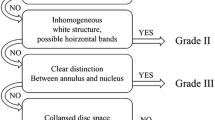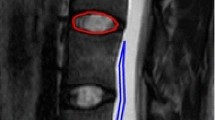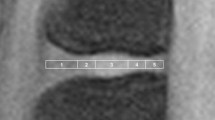Summary
Purpose
The aim of this study was to investigate the possibility of quantitative classification in intervertebral disc degeneration using spin–spin relaxation time (T2) cut-off values with regard to morphological classifications.
Methods
Lumbar magnetic resonance (MR) imaging was performed on 21 subjects (a total of 104 lumbar disks). The T2 relaxation time was measured in the nucleus pulposus using a sagittal multi-echo spin-echo sequence. The morphological classification of disc degeneration was assessed independently by three experienced neuroradiologists according to the Pfirrmann and Schneiderman classifications. Receiver operating characteristic analysis was performed among grades to determine T2 cut-off values in each classification. Intra- and interobserver differences were calculated using kappa statistics.
Results
Moderate overall interobserver agreement was found between observers in both the Pfirrmann and Schneiderman classification schemes (kappa 0.46 and 0.51), while intraobserver reliability was substantial to almost perfect. The interobserver reliability was only fair in Pfirrmann grades III and IV (kappa 0.33 and 0.36), but the T2 cut-off values still indicated a significant difference between grades (p < 0.05).
Conclusions
Interobserver agreement of MR evaluation in patients with intervertebral disc degeneration was only fair to moderate on the classification of more severe disc degeneration in the Pfirrmann and Schneiderman schemes. Based on our results, quantitative T2 cut-off values seem to be a more reliable method to define the degree of disc degeneration, which may help staging intervertebral disc degeneration (IVDD) even if the interobserver reliability is low.




Similar content being viewed by others
References
Schneiderman G, Flannigan B, Kingston S, Thomas J, Dillin WH, Watkins RG. Magnetic resonance imaging in the diagnosis of disc degeneration: correlation with discography. Spine. 1987;12(3):276–81.
Tertti M, Paajanen H, Laato M, Aho H, Komu M, Kormano M. Disc degeneration in magnetic resonance imaging. A comparative biochemical, histologic, and radiologic study in cadaver spines. Spine. 1991;16(6):629–34.
Gunzburg R, Parkinson R, Moore R, Cantraine F, Hutton W, Vernon-Roberts B, et al. A cadaveric study comparing discography, magnetic resonance imaging, histology, and mechanical behavior of the human lumbar disc. Spine. 1992;17(4):417–26.
Pfirrmann CW, Metzdorf A, Zanetti M, Hodler J, Boos N. Magnetic resonance classification of lumbar intervertebral disc degeneration. Spine. 2001;26(17):1873–8.
Kanayama M, Togawa D, Takahashi C, Terai T, Hashimoto T. Cross-sectional magnetic resonance imaging study of lumbar disc degeneration in 200 healthy individuals. J Neurosurg Spine. 2009;11(4):501–7. doi:10.3171/2009.5.SPINE08675.
Griffith JF, Wang YX, Antonio GE, Choi KC, Yu A, Ahuja AT, et al. Modified Pfirrmann grading system for lumbar intervertebral disc degeneration. Spine. 2007;32(24):E708–12. doi:10.1097/BRS.0b013e31815a59a000007632-200711150-00028[pii].
Haneder S, Apprich SR, Schmitt B, Michaely HJ, Schoenberg SO, Friedrich KM, et al. Assessment of glycosaminoglycan content in intervertebral discs using chemical exchange saturation transfer at 3.0 Tesla: preliminary results in patients with low-back pain. Eur Radiol. 2013;23(3):861–8. doi:10.1007/s00330-012-2660-6.
Wang C, Witschey W, Goldberg A, Elliott M, Borthakur A, Reddy R. Magnetization transfer ratio mapping of intervertebral disc degeneration. Magn Reson Med. 2010;64(5):1520–8. doi:10.1002/mrm.22533.
Paajanen H, Komu M, Lehto I, Laato M, Haapasalo H. Magnetization transfer imaging of 2 disc degeneration. Correlation of relaxation parameters with biochemistry. Spine. 1994;19(24):2833–7.
Nguyen AM, Johannessen W, Yoder JH, Wheaton AJ, Vresilovic EJ, Borthakur A, et al. Noninvasive quantification of human nucleus pulposus pressure with use of T1rho-weighted magnetic resonance imaging. J Bone Joint Surg Am. 2008;90(4):796–802. doi:10.2106/JBJS.G.0066790/4/796[pii].
Zobel BB, Vadala G, Del Vescovo R, Battisti S, Martina FM, Stellato L, et al. T1rho magnetic resonance imaging quantification of early lumbar intervertebral disc degeneration in healthy young adults. Spine. 2012;37(14):1224–30. doi:10.1097/BRS.0b013e31824b2450.
Jenkins JP, Hickey DS, Zhu XP, Machin M, Isherwood I. MR imaging of the intervertebral disc: a quantitative study. Br J Radiol. 1985;58(692):705–9.
Zuo J, Saadat E, Romero A, Loo K, Li X, Link TM, et al. Assessment of intervertebral disc degeneration with magnetic resonance single-voxel spectroscopy. Magn Reson Med. 2009;62(5):1140–6. doi:10.1002/mrm.22093.
Beattie PF, Morgan PS, Peters D. Diffusion-weighted magnetic resonance imaging of normal and degenerative lumbar intervertebral discs: a new method to potentially quantify the physiologic effect of physical therapy intervention. J Orthop Sports Phys Ther. 2008;38(2):42–9. doi:10.2519/jospt.2008.26311344[pii].
Niinimaki J, Korkiakoski A, Ojala O, Karppinen J, Ruohonen J, Haapea M, et al. Association between visual degeneration of intervertebral discs and the apparent diffusion coefficient. Magn Reson Imaging. 2009;27(5):641–7. doi:10.1016/j.mri.2008.10.005S0730-725X(08)00340-8[pii].
Perry J, Haughton V, Anderson PA, Wu Y, Fine J, Mistretta C. The value of T2 relaxation times to characterize lumbar intervertebral disks: preliminary results. AJNR Am J Neuroradiol. 2006;27(2):337–42. doi:27/2/337[pii].
Marinelli NL, Haughton VM, Anderson PA. T2 relaxation times correlated with stage of lumbar intervertebral disk degeneration and patient age. AJNR Am J Neuroradiol. 2010;31(7):1278–82. doi:10.3174/ajnr.A2080ajnr.A2080[pii].
Trattnig S, Stelzeneder D, Goed S, Reissegger M, Mamisch TC, Paternostro-Sluga T, et al. Lumbar intervertebral disc abnormalities: comparison of quantitative T2 mapping with conventional MR at 3.0 T. Eur Radiol. 2010;20(11):2715–22. doi:10.1007/s00330-010-1843-2.
Kettler A, Wilke HJ. Review of existing grading systems for cervical or lumbar disc and facet joint degeneration. Eur Spine J. 2006;15(6):705–18. doi:10.1007/s00586-005-0954-y.
Niu G, Yang J, Wang R, Dang S, Wu EX, Guo Y. MR imaging assessment of lumbar intervertebral disk degeneration and age-related changes: apparent diffusion coefficient versus T2 quantitation. AJNR Am J Neuroradiol. 2011;32(9):1617–23. doi:10.3174/ajnr.A2556ajnr.A2556[pii].
Stelzeneder D, Welsch GH, Kovacs BK, Goed S, Paternostro-Sluga T, Vlychou M, et al. Quantitative T2 evaluation at 3.0 T compared to morphological grading of the lumbar intervertebral disc: a standardized evaluation approach in patients with low back pain. Eur J Radiol. 2012;81(2):324–30. doi:10.1016/j.ejrad.2010.12.093S0720-048X(11)00099-4[pii].
Welsch GH, Trattnig S, Paternostro-Sluga T, Bohndorf K, Goed S, Stelzeneder D, et al. Parametric T2 and T2* mapping techniques to visualize intervertebral disc degeneration in patients with low back pain: initial results on the clinical use of 3.0 Tesla MRI. Skeletal Radiol. 2011;40(5):543–51. doi:10.1007/s00256-010-1036-8.
Takashima H, Takebayashi T, Yoshimoto M, Terashima Y, Tsuda H, Ida K, et al. Correlation between T2 relaxation time and intervertebral disk degeneration. Skeletal Radiol. 2012;41(2):163–7. doi:10.1007/s00256-011-1144-0.
Millecamps M, Tajerian M, Naso L, Sage EH, Stone LS. Lumbar intervertebral disc degeneration associated with axial and radiating low back pain in ageing SPARC-null mice. Pain. 2012;153(6):1167–79. doi:10.1016/j.pain.2012.01.027S0304-3959(12)00054-1[pii].
Hughes SP, Freemont AJ, Hukins DW, McGregor AH, Roberts S. The pathogenesis of degeneration of the intervertebral disc and emerging therapies in the management of back pain. J Bone Joint Surg Br. 2012;94(10):1298–304. doi:94-B/10/1298[pii]10.1302/0301-620X.94B10.28986.
Maier CF, Tan SG, Hariharan H, Potter HG. T2 quantitation of articular cartilage at 1.5 T. J Magn Reson Imaging. 2003;17(3):358–64. doi:10.1002/jmri.10263.
Chan YH. Biostatistics 201: linear regression analysis. Singapore Med J. 2004;45(2):55–61.
Landis JR, Koch GG. The measurement of observer agreement for categorical data. Biometrics. 1977;33(1):159–74.
Viera AJ, Garrett JM. Understanding interobserver agreement: the kappa statistic. Fam Med. 2005;37(5):360–3.
Pye SR, Reid DM, Smith R, Adams JE, Nelson K, Silman AJ, et al. Radiographic features of lumbar disc degeneration and self-reported back pain. J Rheumatol. 2004;31(4):753–8. doi:0315162X-31-753[pii].
de Schepper EI, Damen J, van Meurs JB, Ginai AZ, Popham M, Hofman A, et al. The association between lumbar disc degeneration and low back pain: the influence of age, gender, and individual radiographic features. Spine. 2010;35(5):531–6. doi:10.1097/BRS.0b013e3181aa5b33.
Pye SR, Reid DM, Lunt M, Adams JE, Silman AJ, O’Neill TW. Lumbar disc degeneration: association between osteophytes, end-plate sclerosis and disc space narrowing. Ann Rheum Dis. 2007;66(3):330–3. doi:ard.2006.052522[pii]10.1136/ard.2006.052522.
Thompson JP, Pearce RH, Schechter MT, Adams ME, Tsang IK, Bishop PB. Preliminary evaluation of a scheme for grading the gross morphology of the human intervertebral disc. Spine. 1990;15(5):411–5.
Battie MC, Videman T, Parent E. Lumbar disc degeneration: epidemiology and genetic influences. Spine. 2004;29(23):2679–90. doi:00007632-200412010-00012[pii].
Takatalo J, Karppinen J, Niinimaki J, Taimela S, Nayha S, Mutanen P, et al. Does lumbar disc degeneration on magnetic resonance imaging associate with low back symptom severity in young Finnish adults? Spine. 2011;36(25):2180–9. doi:10.1097/BRS.0b013e3182077122.
Modic MT, Steinberg PM, Ross JS, Masaryk TJ, Carter JR. Degenerative disk disease: assessment of changes in vertebral body marrow with MR imaging. Radiology. 1988;166(1 Pt 1):193–9.
Fardon DF, Milette PC. Nomenclature and classification of lumbar disc pathology. Recommendations of the combined task forces of the North American Spine Society, American Society of Spine Radiology, and American Society of Neuroradiology. Spine. 2001;26(5):E93–113.
Yu SW, Sether LA, Ho PS, Wagner M, Haughton VM. Tears of the anulus fibrosus: correlation between MR and pathologic findings in cadavers. AJNR Am J Neuroradiol. 1988;9(2):367–70.
Aprill C, Bogduk N. High-intensity zone: a diagnostic sign of painful lumbar disc on magnetic resonance imaging. Br J Radiol. 1992;65(773):361–9.
Watanabe A, Benneker LM, Boesch C, Watanabe T, Obata T, Anderson SE. Classification of intervertebral disk degeneration with axial T2 mapping. AJR Am J Roentgenol. 2007;189(4):936–42. doi:189/4/936[pii]10.2214/AJR.07.2142.
Sim J, Wright CC. The kappa statistic in reliability studies: use, interpretation, and sample size requirements. Phys Ther. 2005;85(3):257–68.
Lurie JD, Tosteson AN, Tosteson TD, Carragee E, Carrino JA, Kaiser J, et al. Reliability of magnetic resonance imaging readings for lumbar disc herniation in the Spine Patient Outcomes Research Trial (SPORT). Spine. 2008;33(9):991–8. doi:10.1097/BRS.0b013e31816c837900007632-200804200-00011[pii].
Cheung KM, Karppinen J, Chan D, Ho DW, Song YQ, Sham P, et al. Prevalence and pattern of lumbar magnetic resonance imaging changes in a population study of one thousand forty-three individuals. Spine. 2009;34(9):934–40. doi:10.1097/BRS.0b013e3181a01b3f00007632-200904200-00012[pii].
Jensen TS, Sorensen JS, Kjaer P. Intra- and inter-observer reproducibility of vertebral endplate signal (modic) changes in the lumbar spine: the Nordic Modic Consensus Group classification. Acta Radiol. 2007;48(7):748–54. doi:781629176 [pii]10.1080/02841850701422112.
Manchikanti L, Glaser SE, Wolfer L, Derby R, Cohen SP. Systematic review of lumbar discography as a diagnostic test for chronic low back pain. Pain Physician. 2009;12(3):541–59.
Wilkens P, Storheim K, Scheel I, Berg L, Espeland A. No effect of 6-month intake of glucosamine sulfate on Modic changes or high intensity zones in the lumbar spine: sub-group analysis of a randomized controlled trial. J Negat Results Biomed. 2012;11:13. doi:10.1186/1477-5751-11-131477-5751-11-13[pii].
Carrino JA, Lurie JD, Tosteson AN, Tosteson TD, Carragee EJ, Kaiser J, et al. Lumbar spine: reliability of MR imaging findings. Radiology. 2009;250(1):161–70. doi:10.1148/radiol.24930719992493071999[pii].
Yu LP, Qian WW, Yin GY, Ren YX, Hu ZY. MRI assessment of lumbar intervertebral disc degeneration with lumbar degenerative disease using the pfirrmann grading systems. PLoS One. 2012;7(12):e48074. doi:10.1371/journal.pone.0048074PONE-D-12-13150[pii].
Arana E, Royuela A, Kovacs FM, Estremera A, Sarasibar H, Amengual G, et al. Lumbar spine: agreement in the interpretation of 1.5-T MR images by using the Nordic Modic Consensus Group classification form. Radiology. 2010;254(3):809–17. doi:10.1148/radiol.09090706radiol.09090706[pii].
Hangai M, Kaneoka K, Hinotsu S, Shimizu K, Okubo Y, Miyakawa S, et al. Lumbar intervertebral disk degeneration in athletes. Am J Sports Med. 2009;37(1):149–55. doi:10.1177/03635465083232520363546508323252[pii].
Urban JP, McMullin JF. Swelling pressure of the lumbar intervertebral discs: influence of age, spinal level, composition, and degeneration. Spine. 1988;13(2):179–87.
Zou J, Yang H, Miyazaki M, Morishita Y, Wei F, McGovern S, et al. Dynamic bulging of intervertebral discs in the degenerative lumbar spine. Spine. 2009;34(23):2545–50. doi:10.1097/BRS.0b013e3181b32998.
Claudia C, Farida C, Guy G, Marie-Claude M, Carl-Eric A. Quantitative evaluation of an automatic segmentation method for 3D reconstruction of intervertebral scoliotic disks from MR images. BMC Med Imaging. 2012;12:26. doi:10.1186/1471-2342-12-261471-2342-12-26[pii].
Mulkern RV, Wong ST, Jakab P, Bleier AR, Sandor T, Jolesz FA. CPMG imaging sequences for high field in vivo transverse relaxation studies. Magn Reson Med. 1990;16(1):67–79.
Acknowledgment
The project was supported by research grants SROP-4.2.1.B-10/2/KONV-2010–0002, (Developing the South-Transdanubian Regional University Competitiveness), SROP-4.2.2/A- 11/1/KONV-2012–0017 and Hungarian Scientific Research Found OTKA-K109132. AS was supported by the Bolyai Scholarship of Hungarian Academy of Science. The local Diagnostic Center, Mihály Aradi M.D., Prof. József Janszky M.D., Ph.D., D.Sc. and Szilvia Erdélyi-Bótor M.D. are gratefully acknowledged for the MR imaging and technical advices.
Conflict of Interest
The authors declare that they have no conflict of interest.
Author information
Authors and Affiliations
Corresponding author
Additional information
The first two authors have contributed equally to this article.
Rights and permissions
About this article
Cite this article
Nagy, S., Juhasz, I., Komaromy, H. et al. A Statistical Model for Intervertebral Disc Degeneration: Determination of the Optimal T2 Cut-Off Values. Clin Neuroradiol 24, 355–363 (2014). https://doi.org/10.1007/s00062-013-0266-2
Received:
Accepted:
Published:
Issue Date:
DOI: https://doi.org/10.1007/s00062-013-0266-2




